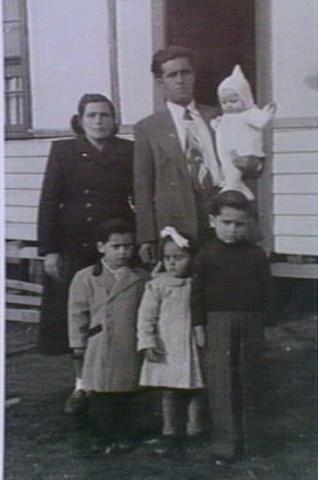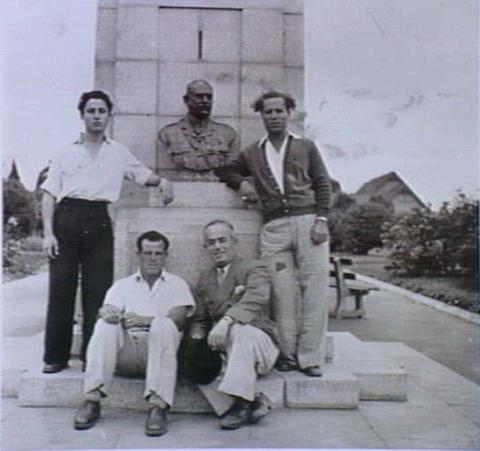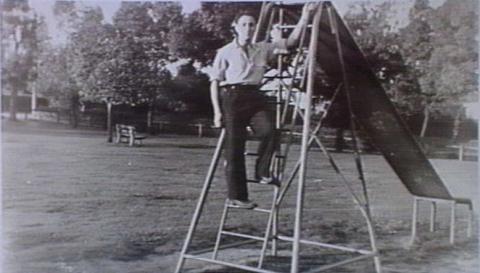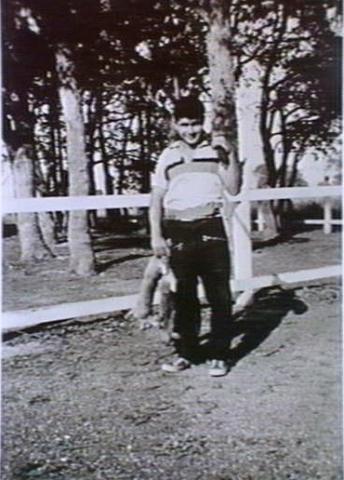1950 - A NEW HOME FOR THE BRAVE PEOPLE OF MALTA
It is documented that in the period 1945-65, more than two million migrants came to Australia…
“Most were assisted: the Commonwealth Government paid most of their fare to get to Australia. In return they had to stay in Australia for at least two years and work in whatever jobs the Government gave them.” ‘Migration-heritage’ website.
Many new arrivals found homes in the Latrobe Valley and worked for the SECV at Yallourn. In her chapter, relating to the employment of migrants within the SECV, Prue McGoldrick wrote…
“Migrants were not only a welcome addition to the workforce-their very number stimulated industry- but also, as a bonus they brought with them the skills and the arts of their homelands thus heralding a significant change in the Australian economy “ ‘Yallourn Was. Page: 132.
One only has to examine the family names of boys attending the Yallourn Technical School during the 1950’s-60’s (as published in editions the ‘Current Call' magazine) to appreciate the vast number of students whose parents had decided to leave the war-torn countries of Europe and seek ‘new lives’ Australia (and, in turn, the Latrobe Valley) .
The familial names of YTS students are an indication of the substantial immigration program of that era; and also a living example of the vital importance of migrants to the SECV.
Among the thousands of Europeans who made their homes in the Latrobe Valley, there were many from the small Mediterranean islands of Gozo, Comino and Malta; and the following newspaper article, which was published in ‘The Age’ in 1950, tells of 190 tradesmen from Malta who had successfully gained employment with the SECV.
The contribution of the Maltese families, of Moe, Newborough, Yallourn, Yallourn North and Morwell, to building the Victorian economy and weaving a strong thread in the social fabric of the Latrobe Valley deserves acknowledgement and admiration.
The footnotes provided with this newspaper extract endeavour to assist younger readers understand the background history of the Maltese in Australia.
Footnotes 16-22 briefly outline the courageous stand that the people of Malta made ‘against incredible odds’ in defending their ‘island home’ during World War:II.
FEBRUARY 23RD 1950 ‘THE AGE’ PAGE:2
MALTESE MIGRANTS TO WORK FOR S.E.C.
A party of 190 tradesmen migrants from Malta, nominated by the State Electricity Commission for work at Yallourn and Kiewa, sailed for Australia in the Asturias yesterday. They are due in Melbourne about March 9.
Nearly all the Maltese are carpenters, 90 of whom will go to Kiewa and 70 to Yallourn. The rest are plumbers, electrical and mechanical fitters, turners and riggers — who will all go to Yallourn. Most of the migrants are former workers at the naval dockyards in Malta. All have been trade tested. All have contributed part of their passage money to Australia. Every man has undertaken to work a minimum of one year with the S.E.C. The men are to receive the full award wages for their respective trades; and will have the same accommodation as other single men working at Yallourn and Kiewa.
An S.E.C. personnel officer will meet the Asturias at Fremantle and travel with the party to Melbourne. On arrival in Melbourne he will be assisted by a Maltese now working at Yallourn, who came to Australia with a smaller group of Maltese
Nominated by the S.E.C. early last year. A further small party of S.E.C.-nominated migrants will follow from Malta within the next few days in the Ocean Victory.
FOOTNOTES REGARDING THE ABOVE NEWSPAPER ARTICLE.
1. It is stated that the first Maltese people to arrive in Australia were convicts in 1810 as …
“ The first Maltese to arrive in Australia were convicts, transported in the 1810s for deserting their British regiments. Malta was then a British colony.” Museum-Victoria website.
2. Antoni Azzopardi, a businessman, is said to have been the first free-settler from Malta to live in Australia. According to the Museum of Victoria website, there were only 73 Maltese-born migrants living in Australia in 1881.
3. The opportunities to obtain work in the coal mining and power generation industries were major factors in bringing people to Australia in the 20th century. What began as a trickle in the early 1900’s became a stream in the post-war era with the massive projects undertaken in Gippsland by the SECV…
“Black coal at Wonthaggi from 1910 brought British, Scots and Italian miners among others. Brown coal in the Latrobe valley attracted Australian and British Isles workers to Yallourn in the 1920s…” From: ‘ Gippsland Immigration Park’ website.
4. One of the earliest newspaper references regarding Maltese employees in the Yallourn area was unearthed in the ‘Morwell Advertiser’ in 1922. The article was simply headlined: ‘YALLOURN’; and it reported that a Maltese worker, Mr Angelo Corrabut, who had his foot amputated as the result of an industrial accident (probably at a mine worksite). The report also mentioned that Mr Corrabut’s wife and child were to arrive in Yallourn later in April that year. (‘Morwell Advertiser’ April 7th 1922 Page: 3).
5. In her authoritative book about the history of Yallourn entitled ‘Digging People Up For Coal’, Meredith Fletcher stated…
“Maltese workers were another definable group at the Yallourn works. In 1927, in a workforce of 1530 men, 102 were Maltese” Page: 62.
Meredith also refers to a well-known Maltese emigrant, Tony Esposito, who worked initially at the Brown Coal Mine in 1923 and then gained work at the Yallourn briquette factory. Some readers of this website may recall Tony in his later years.
6. A Maltese worker, Joe Vella, made the news in a major metropolitan newspaper when he was involved in a serious mishap while working at his home at the Brown Coal Mine in April 1927 …
“Maltese’s Painful Injury. YALLOURN ,Monday — Joseph Vella , a Maltese, while engaged in doing some carpentering at his home at the Brown Coal Mine this afternoon, slipped off a scaffolding on which he was standing, and fell to the ground. A rusty nail projecting from a piece of timber entered his head about half an inch from his temple, penetrating deeply. Pulling the nail out himself, he paid little attention to it. Some hours later he became violently ill, necessitating medical attention. His condition at present is uncertain.” ‘The Age’ April 19th 1927 Page: 8.
7. The ‘Morwell Advertiser’ in September 1928 made a brief reference to the existence of an ‘Italian – Maltese Camp’ for workers involved in the Yallourn project.
8. In 1931, the ‘Queensland Times’ (an Ipswich newspaper ) reported the opinions of Mr. Corder, the Commissioner for Malta, who spoke at a function in Melbourne in September that year..
“…The earliest Maltese to arrive in Australia went to Central Queensland 50 years ago,” said the Commissioner for Malta (Mr F. J. Corder) at commemorative dinner in Melbourne recently. “Practically all Maltese immigrants started here without money and in many cases, they took up land that would otherwise have been abandoned. They had met bitter and disheartening prejudice,” and he (Mr Corder) thought Australians should not discriminate against Maltese as a non-British people. “There were a number of Maltese labourers working in the mines in Tasmania, Broken Hill, and Yallourn…” ‘Queensland Times’ September 14th 1931. Page: 8
9. It is known that Mr J.A. P. Gerrard, the SECV’s Industrial Officer, travelled overseas in the late 1940’s to seek the possibility of men from the UK and Europe coming to work in the expanding Victorian power industry. There is every possibility that the 190 men, mentioned in the above extract, were part of that recruitment program. The following quotation was taken from the ‘Gippsland Immigration Park’ website…
“Further developments from the late 1940s onwards, based on Morwell, brought in the biggest ethnic migration in Gippsland’s history, many of them the victims of the Second World War: Italians, Maltese, Greeks and Yugoslavs from southern Europe, and Dutch, Germans, Poles, Ukrainians, Russians and Baltic peoples from northern Europe, as well as more immigrants from the British Isles.”
10. In 1949, the arrival of 751 men, women and children from Malta aboard the SS Misr made the front page news in ‘The Age’ newspaper. The item briefly mentioned that fifty-three of the passengers would be working at Yallourn…
“The largest party, 53 tradesmen, will be employed by the S.E.C. at Yallourn. The migrants are nearly all former servicemen, many of whom were sponsored by officers and men of Australian units with which they served during the war. They are mostly farmers and experienced dock workers…” ‘The Age’ May 30th 1949 Page:1
11. In June 1950, ‘The Age’ reported that the SS Asturias had arrived at Port Melbourne with more than 1300 British and Maltese migrants (including 334 children). Forty six of the new arrivals were then to travel onto Yallourn and commence work with the SECV. Sadly, the press item also included news of the death of a young Maltese farmer during the voyage…
“ Asturias Brings More Migrants…The Asturias arrived at Port Melbourne on Saturday with 1066 British migrants and 285 Maltese. These included 344 children under 14 years. Of the total, 382 British and 113 Maltese disembarked here. Already 143, including 23 Maltese, had left the ship at Fremantle.
A 21-year-old Maltese farmer, Mr. Victor Hill, died from pneumonia a few days before the ship reached Fremantle, and was buried at sea. Included in the migrants were 14 sponsored by the Returned Servicemen's League and 46 going to Yallourn for the State Electricity Commission…” ‘The Age’ June 12th 1950 Page: 4
Available records indicate that thousands of Maltese migrants travelled aboard the Asturia to Australia …
“In 1948 Australia signed an assisted passenger agreement with Malta. Thousands of Maltese migrants came to Australia in the 1940s and early 1950s on the SS Asturias.” www. ssasturiss.net
12. Further to Mr Gerrard’s successful ‘expedition’ to Europe to recruit workers for the Victorian Power industry, the following extract gives some indication of the number of Maltese workers who arrived in Victoria between 1950 and 1966…
“During World War: I Maltese immigration was severely restricted, and a quota system for Maltese was introduced in 1920. International pressure resulted in the quota being raised in 1923, and 395 Malta-born people lived in Victoria by 1933.In 1948 an assisted passage agreement was signed with Malta, the first such agreement Australia had made with any country other than Britain. This resulted in large numbers of arrivals, peaking in the 1950s. By 1966, the Malta-born population of Victoria was 26,452.” Museum of Victoria website.
13. In researching this story for the Virtual Yallourn website, it was very difficult to discover the precise number of Maltese families who lived in the township of Yallourn, at Yallourn North, the Married Quarters or in the single men’s camps (Eastern and Western). However, in a 1964 book by Jerzy Zubryzycki, entitled ‘Settlers of the Latrobe Valley’, the residential distribution of Maltese’ immigrants in the Latrobe Valley is recorded in the form of a chart. Mr Zubryzycki’s study ( page: 52) indicates that in the 1950’s and early 60’s, most Maltese families resided at Yallourn North (42%) while 20% chose to live in Newborough and at Moe (16%). Very few Maltese families resided in the township of Yallourn.
14. Jerzy Zubrzycki’s book devotes at least eight pages to the Maltese community of Yallourn North; and some paragraphs underscore how difficult life was for many Maltese families in settling into the Australian way of life.
15. Life was very challenging for Maltese families in the Latrobe Valley; not only was there a difficult language barrier to overcome but it is written that many settlers missed their religious festivals, music, extended families and the interaction of village life. However, despite the trying conditions in a ‘new’ land, the greater majority of Maltese ‘stayed on’ in the ‘Valley and weathered severe ‘homesickness’; and, in time, enjoyed rewarding lives in their local communities. Conditions were often harsh for the Maltese families; but, it is fair to say that, the children had educational and employment opportunities in the Latrobe Valley that most children in post-war Malta would have envied.
16. Younger readers of this website may not be aware of the distress that the inhabitants of the small island(s) of Malta faced during World War: II. Because of the strategic importance of Malta, in the battle to control the Mediterranean Sea, Malta faced relentless air raids from 1940-1943. It is stated, in numerous texts, that Malta was the ‘most bombed’ area in the war.
17. Although the island of Malta is only 122 square miles, it has been verified that 16,000 tons of bombs were dropped on Valletta, Floriana, Senglea, Luqa and other towns during that ruthless bombardment.
18. In the early years of World War: II, a world-wide ‘Malta Relief Fund’ was established to assist those people who had suffered distress and loss during the bombings. Australians gave generously to the appeal and raised £21,309 (pounds) in addition to other assistance (e.g. Red Cross). It was difficult to discover the amount of money that the residents of Yallourn donated to that national appeal.
19. As mentioned above, many of the Maltese men, who found work at Yallourn in 1950, had worked at the Naval Dockyards at the Grand Harbour in Valletta during the war. The dockyards were a prime target in the bombing raids. Most of the men, who eventually arrived in Yallourn, would have experienced dangerous and frightening times in their previous workplaces.
20. Malta paid a high price in those desperate years. By the end of the war, there were some 5,300 casualties, including 1500 deaths (400 children), or people deemed to be missing. One reference said that, during World War: II, the people of Malta spent a total in excess of 2300 hours in air raid shelters.
Most of Malta’s infrastructure and public buildings were reduced to rubble by the incessant air-raids during that period. When reading the history of wartime of Malta, it is a miracle how the people, particularly the children, lived through the nightmare of such a blitzkrieg.
21. While the air raids were deadly, food shortages saw people on the island perish through hunger. In what became known as the Siege of Malta, the Axis powers endeavoured to starve the people of Malta into submission. One wartime diary reveals that, in 1942, the infant mortality rate on the island had climbed to 33%. It is known that untold deaths among the elderly due were caused by extreme deprivation.
22. The brave people of Malta were awarded the George Cross. Malta was the very first British Commonwealth country to receive such an honour. The George Cross was usually awarded to individuals for their courage under fire; but, in a letter to Governor Dobbie of Malta in April 1942, King George VI wrote …
“To honour her brave people, I award the George Cross to the Island Fortress of Malta to bear witness to heroism and a devotion that will be long known in history. King George VI.”
23. The Roman Catholic weekly newspaper (‘The Advocate’) reported in March 1951 that all Maltese shift workers at the Yallourn work sites had the opportunity to attend specially organized religious services which were conducted by a Maltese priest named Rev. Grech …
“ YALLOURN…Maltese workers on the three shifts at the State Electricity Commission's projects at Yallourn found time to attend the exercises of a week's mission given by Rev. Augustine Grech, S.S.P., recently. The Maltese priest had been invited to the parish by Rev. J. Walsh, P.P…” ‘The Advocate’ March 22nd 1951 Page 16.
Note: Rev.Fr John Walsh was the first Priest at St Therese’s Church Yallourn and he served the Parish from 1937-1962. He died at Yallourn in 1962 at the age of 59.
24. A British film, called ‘Malta Story’ (starring Jack Hawkins and Alec Guinness) was made in 1953. The movie, which deals with the courage and resilience of the people during the Siege of Malta during World War: 2, was shown in the Yallourn Theatre on the 13th, 14th and 16th of August in 1954. Some of the readers of this website may have seen that film at the town’s cinema.
25. The most recent figures show that there are approximately 20,000 Maltese living in Victoria; and it is known that 3,000 Maltese (either born in Malta or with a Maltese background) currently live in the Latrobe Valley.
26. Some of the well-known Maltese families who resided or still live at Yallourn North include: Vella , Attard, Pace ( family of 18 children ), Sultana, ( market garden and farm ), *Manicola (came out prior to World War:II and was renowned for growing vegetables, potato and corn), Grima, Carabez, Bajada, Mallia, Cassa, Farrugia, Grixti , Galea, and Tabone** ( see below).
27. A story of Joe Manicola, who died at Heidelberg Repatriation Hospital on March 12th 1969 while undertaking National Service, can also be found on this website. Type the word ‘Manicola’ into the ‘search field’ (top right hand corner of this screen) and press ‘Enter.’
28. Well-known Maltese family names which can be found in the townships of Newborough, Morwell and Moe include: Spiteri, Tanti, Borg, Frendo, Buhagiar, Bugeja, Schembri, Pace, Azzopardi, Gatt, Fenech, Sammut, Grech, Palma, Busuttil, Cauchi, Chircop, DeBono, Falzon, Micallef, Muscat, Zammit, Xuereb, Xerri, Sciberras, Said, Mifsud and Ellul.
29. The following Maltese residents, from the Moe and Morwell , have gained considerable success in their respective sports…
• Jason Bright - Professional V8 Super car driver from Moe, (Maltese parents). Refer to: https://en.wikipedia.org/wiki/Jason_Bright . Jason and co-driver Steven Richards won the Bathurst Classic (the V8Supercar version of the Bathurst 1000 that year) in 1998.
• *John Hutchinson – Professional Football/Soccer Player from Morwell (Maltese Parents) John captained the Central Coast Mariners ‘A’ League team and also played international football for Malta.
*Note: The above John is not to be confused with John Hutchinson who coached Yallourn Football (Australian Rules) Club and played with Fitzroy FC in 1957.
• Rebecca Madyson - Trap Shooter Commonwealth Games is also from Morwell. See: http://www.smh.com.au/news/shooting/medal-goes-to-malta-by special delivery/2006/03/21/1142703363860.html
30. In March 2016, more than 4500 people attended the inaugural Latrobe Valley Maltese Festival which was held at Kernot Hall in Morwell. **Frank Tabone (see below), who organised the event, said....
“Its aim was to bring an experience of Maltese culture and tradition to the Valley, with families and children enjoying an array of entertainment, food and beverages.” ‘The Latrobe Valley Express’ March 3rd 2016.
Not only was the festival a successful social occasion for the Maltese community but the event raised more than $10,000 for Gippsland Rotary Centenary House (an accommodation centre for families of cancer patients in the region.)
A SPECIAL ‘THANK YOU’ TO FRANK TABONE FROM VIRTUAL YALLOURN.
Sincere appreciation is expressed to Mr. Frank Tabone (who resides in Traralgon but grew up living in Morwell and Yallourn North) for his kind assistance and whole-hearted support in writing the footnotes (26-30) for this article for the Virtual Yallourn website.
Frank Tabone’s family history is indeed pertinent to the above newspaper extract and is a perfect example of the arrival of Maltese settlers to work for the SECV at Yallourn.
Frank’s grandfather (Paul Tabone) came from Malta in 1950 aboard the SS Asturias (see above). On his arrival, Paul went to work at Yallourn; and twelve months later his entire family arrived from Malta; this included his wife Mary ( Frank’s grandmother ) and six children, including Frank’s father (who was 2 years old at time of travelling to Australia). A seventh Tabone child was later born in Australia.
Finally, thanks the staff of the Rosebud Library for assistance in providing an inter-library loan for the ‘rare’ text ‘Settlers of the Latrobe Valley.’
SOURCES OF INFORMATION FOR THIS ARTICLE :
1. ‘The Santa Marija Convoy –Faith and Endurance in Wartime Malta 1940-42’- Dennis. A. Castillo – Lexington Books 2012.
2. ‘Halliwell’s Film Guide’-2006.
3. ‘SS Asturias’ website.
4. ‘Migration-heritage’ website.
5. ‘Settlers of the Latrobe Valley’ Jerzy Zubrzycki. ANU Press 1964.
6. ‘Digging People Up For Coal’ –Meredith Fletcher. MUP 2002.
7. National Geographic Series : ‘War Heroes of the Skies’ -The story of Canadian World War: 2 fighter pilot, George Beurling who became known as the ‘Falcon Of Malta’ during the ‘dogfights’ over Malta in 1942.
8. ‘185: The Malta Squadron’ -Anthony Rogers History Press. 2005.
9. ‘Yallourn Was’- Prue McGoldrick.
10. ‘Current Call’- Yallourn Technical College 1959.
11. National Library of Australia.
12. ‘Gippsland-Immigration Park’ website.
13. Museum Victoria.
The above story is part of an on-going project regarding the history of Yallourn. The story was researched and written by and Roger Spaull and presented and posted by Julie George for the Virtual Yallourn website in May 2017.
Julie would welcome any photos or anecdotes regarding the above article to post on the website; and for a list of titles in this series, which commenced in December 2014, please contact Julie.
The above article from the ‘The Age’ has been faithfully reproduced. The only amendments to the original copy are the font style, font size and spacing, so as to enhance the article for purposes of posting on the Virtual Yallourn website.
THE END





